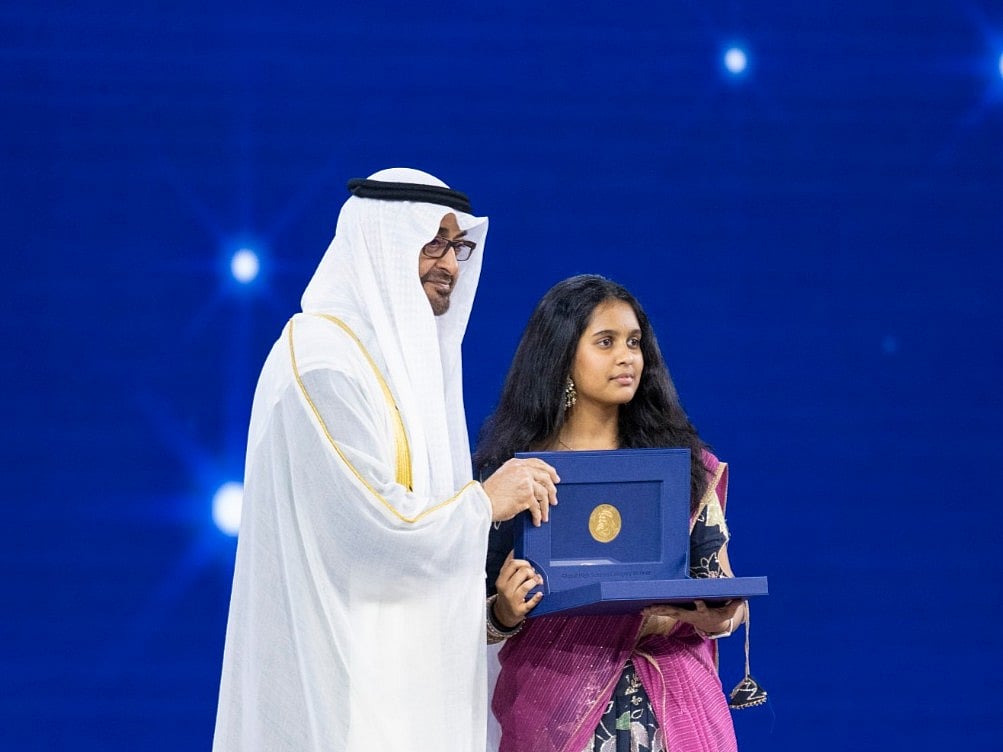Meet the Abu Dhabi Indian student presented Zayed Sustainability Prize by UAE President
Sheikh Mohamed also gave Monica Akkineni a high-five at ceremony last week

Abu Dhabi: It was a double delight for Monica Akkineni, a Grade 10 student at Merryland International School in Abu Dhabi when the school won the Zayed Sustainability Prize last week for an innovative project to reduce carbon emissions.
President His Highness Sheikh Mohamed bin Zayed Al Nahyan presented Akkineni the award for the project, developed with her classmate Muskan Maheshwari. The project focused on creating carbon tiles infused with green algae to purify the air.
Speaking about her turn to receive the award in the Global High Schools, MENA category, Monica said: “Meeting His Highness was a once-in-a-lifetime opportunity. Walking out there and meeting him... he was very patient and kind.”
As she received the award, Muskan and school principal Subha Clifford cheered from the audience at the ceremony in Abu Dhabi.
“His Highness said he was really proud to see someone from his country receive the Prize,” Monica said. “I responded to His Highness that it was an honour to meet him and follow his footsteps on innovation and sustainability.”
As she was about to leave, the President gave her a high-five. “It was a memorable moment,” she said.
‘Living wall’
Their winning project is designing tiles made from sustainable materials, infused with algae to create a “living wall” that absorbs carbon dioxide and releases oxygen. They named it the “carbon sponge tiles”.
Muskan, who is also in Grade 10, explained the inspiration behind their project.
“We were working on sustainable ideas and realised that algae play a significant role in absorbing carbon dioxide [CO2] from the atmosphere. We wanted to highlight algae as a solution for reducing carbon emissions,” she said.
The duo focused on chlorella vulgaris, a microalgae known for its CO2 absorption abilities. “Algae could be the superhero we all are looking for when it comes to reducing carbon footprints.”
What was the result?
To test the effectiveness of their project, they placed several tiles in small glass houses. They also had another glass house without the tiles. And they observed a significant reduction in CO2 levels.
“The glasshouse without the tile had CO2 levels of 1,170 parts per million (ppm) and the one with the tile had just 770 ppm after just an hour. Imagine the impact on health and the environment if these are kept in public places,” Monica said.
Future goals
Clifford, the school principal, noted that winning the Prize was a “monumental achievement”, and the school is exploring ways to address pollution in alignment with the United Nations Sustainable Development Goals.
“We have created a model living wall and made about 35 to 40 tiles. We’ve already seen the difference in CO2 levels in our prototype rooms, and we’re confident this technology will be effective in many places in the future.”
Sign up for the Daily Briefing
Get the latest news and updates straight to your inbox
Network Links
GN StoreDownload our app
© Al Nisr Publishing LLC 2025. All rights reserved.